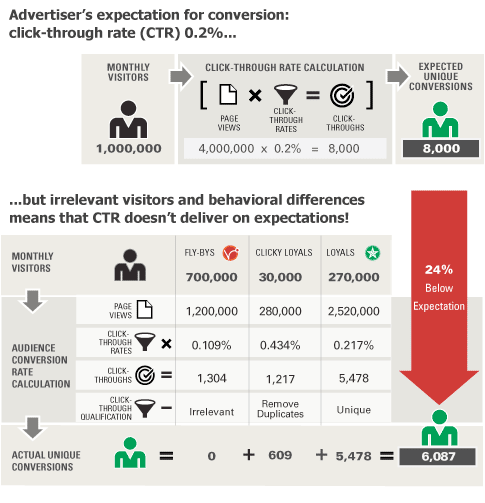Click-through rate (CTR) is often used to describe the advertising performance on a publisher’s site. CTR for an ad is defined as the number of clicks on an ad divided by the number of times the ad is shown (impressions), expressed as a percentage. If the ad sales team for a publisher claims 1 million monthly unique visitors with 4 million page views and a CTR of 0.2% (or 8,000 click-throughs), the buyer might think those click-throughs are all distributed across the million unique users to yield 8,000 unique conversions. The buyer and the seller are wrong.
Here’s the problem: CTR doesn’t take into account audience engagement, not to mention the fact that other advertisers are competing for the click-through on the same page. To demonstrate the weakness of CTR as a performance metric, let’s assume a single advertiser buys the entire inventory for the month. The advertiser buys all 4 million page views from the 1 million uniques to have an expected 8,000 unique visitors click through to the advertiser’s site. But two factors skew actual unique conversion from the CTR’s expected unique conversions: CTR differences between visitors and click-through qualification.
- Scout Analytics research shows that the advertiser’s desired conversion target, the loyal audience, usually comprises 20-30% of the visitors who generate 70-80% of the page views. This means that the available audience for the advertiser is really 200,000-300,000 visitors not 1 million. The remaining 700,000 audience members – those generated from search – are irrelevant to the advertiser.
- Scout Analytics research also finds that click-through behavior varies by engagement, with loyal audience members delivering the majority of click-throughs because of relevance. For a myriad of reasons, the 700,000 irrelevant fly-bys still generate click-throughs, but at a lower CTR. For this example, let’s assume their CTR is half that of a loyal audience.
- Finally, Scout Analytics research shows that some audience members are more “clicky” than others – meaning they click on ads more frequently. The clicky audience not only generates click-throughs more frequently, but often do so on the same ad, distorting the CTR further. (This example assumes 10% of the loyal audience is twice as clicky as the average loyal audience member.) Click-throughs from clicky audience members need to be de-duplicated.
After solving a couple of simultaneous equations, the CTR of the average loyal audience is 0.217%; the clicky audience’s CTR is 0.434%; and the fly-by CTR is 0.109% The graphic below shows what these CTRs do in delivering conversion rates. The horizontal calculation follows traditional CTR thinking to yield the expected 8,000 unique conversions. The vertical calculation, called Audience Conversion Rate (ACR), follows a methodology of tracking unique audience conversions by qualifying the click-throughs as in-market and unique. Rather than getting 8,000 target audience members to click through, the advertiser would actually get 6,087, a full 24% short of the expected 8,000.
The more relevant ACR metric measures the number of unique audience members that clicked through divided by the total number of loyal audience members. Looking at the above example, the publisher is actually producing 2% ACR (i.e., 6,087/300,000). Not only is the 2% rate more representative of publisher and media performance, it is also a better value proposition to the advertiser. This makes your ad sales more productive.






